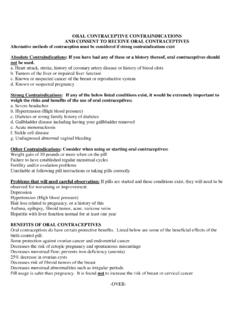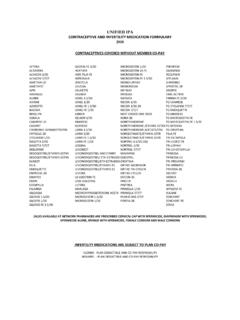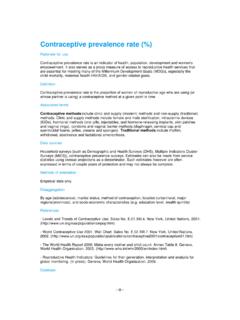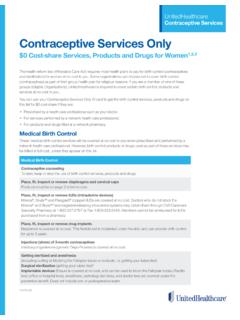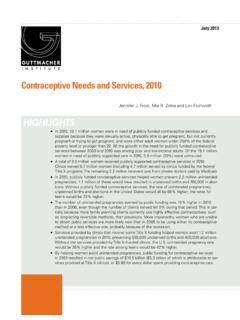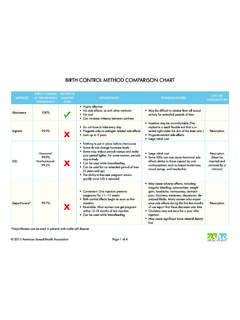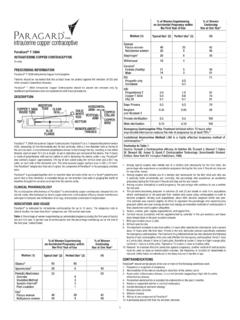Transcription of New contraceptive eligibility checklists for provision …
1 New contraceptive eligibility checklists forprovision of combined oral contraceptivesand depot-medroxyprogesterone acetatein community-based programmesAmanda Stang,1 Pamela Schwingl,2& Roberto Rivera3 Community-based services (CBS) have long used checklists to determine eligibility for contraceptive method use, inparticular for combined oral contraceptives (COCs) and the 3-month injectable contraceptive depot-medroxyprogesterone acetate (DMPA). As safety information changes, however, checklists can quickly becomeoutdated.
2 Inconsistent checklists and eligibility criteria often cause uneven access to contraceptives. In 1996, WHOproduced updated eligibility criteria for the use of all contraceptive methods. Based on these criteria, new checklistsfor COCs and DMPA were developed. This article describes the new checklists and their development. Severalrounds of expert review produced checklists that were correct, comprehensible and consistent with the eligibilityrequirements. Nevertheless, field-testing of the checklists revealed that approximately half (48%) of therespondents felt that one or more questions still needed greater comprehensibility.
3 These findings indicated theneed for a checklist March 2000, WHO convened a meeting of experts to review the medical eligibility criteria for contraceptiveuse. The article reflects also the resulting updated :community health services; contraceptives, oral, combined, contraindications; drug incompatibility; eligibility determination standards; guidelines; medroxyprogesterone 17-acetate, page 1021 le re sume en franc ais. En la pa gina 1022 figura un resumen en espan expand family planning services outside thetraditional setting of the clinic, many reproductivehealth care programmes have employed a system ofcommunity-based family planning services (CBS).
4 These programmes identify women who can safelyuse hormonal methods of contraception. Among themost important tools used in these services are simplechecklists. These checklists commonly contain ques-tionsina yes/no formatthatidentifyconditions(suchas breastfeeding or a history of stroke) which makeclients unsuitable for hormonal contraception withoutmedical evaluation. The use of checklists is especiallyimportant in remote areas where medically administer eligibility checklists are generally non-health care professionals who receive basic training inthe provision of family planning services.
5 The advan-tagesofCBSsystemsinclude thereductionofpossiblesocialdifferencesb etweenproviderandconsumer andlower costs of contraceptive distribution compared toclinics and hospitals (1).Throughout the world, checklists have beenusedtodelivercombinedoralcontracepti ves(COCs)and injectables such as depot-medroxyprogesteroneacetate (DMPA) effectively and safely. However,problemsmay arise when community-basedworkersuse outdated and inaccurate checklists . These maycontain outdated eligibility criteria that do not reflectcurrent information on the safety of differentcontraceptive methods, thus excluding an eligiblewoman from using the contraceptive of her choice,or permitting the use of a contraceptive method thatis medically unsafe for her.
6 To address this problem,we present the following new checklists to assesseligibility for COC and DMP Ause through CBSprogrammes (see Fig. 1 and Fig. 2).In the early 1990s, US family planningresearchers documented that women in manycountries were being denied contraceptives on thebasis of outmoded eligibility criteria. Situationanalyses showed major discrepancies between exist-ing access and contraceptive needs in a number ofdeveloping countries (2). An inventory of familyplanning service delivery guidelines was thereforecompiled (3)
7 To document the pervasiveness ofoutmoded and inconsistent eligibility criteria at both1 Senior Educational Specialist, Family Health International, ResearchTriangle Park, Durham, NC, Epidemiologist, Family Health International, Research TrianglePark, Durham, NC, Director, International Medical Affairs, Family HealthInternational, Research Triangle Park, Durham, NC 27713, USA Correspondence should be addressed to this of the World Health Organization, 2000,78(8)#World Health Organization 2000national and international levels.
8 As long as CBSprogrammes were basing service delivery decisionson outdated criteria, access to contraception andquality of service would be international organizations sought toaddress this issue by initiating a global programme(Maximizing Access and Quality). This strategy wasdesigned to improve access to higher quality contra-ceptive services. As part of this initiative, scientificallyvalidated guidelines for provision of contraceptionthat could be used by policy-makers and providerswere prepared.
9 USAID s Technical Guidance/ Com-petenceWorkingGroup(TG/CWG)assignedF amilyHealth International the task of creating COC andDMP Achecklists for use in the CBS convened family planning and repro-ductive health experts from around the world toreview existing knowledge on the safety of contra-ceptive methods. This review produced the WHOdocumentImproving access to quality care in familyplanning: medical eligibility criteria for contraceptive use(4).bFour categories of eligibility for each contraceptivemethod are described:Category 1 conditions with no restriction on theuse of the contraceptive method;Category 2 conditions where the advantages ofthe method generally outweigh thetheoretical or proven risks;Category 3 conditions where the theoretical orproven risks usually outweigh theadvantages.
10 Category 4 conditions which present an unac-ceptable health risk if the contra-ceptive method is experts who created this classification schemeproposed that where clinical judgement resourcesare limited , such as in community-based services,the four-category framework can be simplified intotwo categories. In such a situation, women in WHOcategories1and2areeligibletouseCOCand DMPA methods of contraception and women in WHOcategories 3 and 4 are and ResultsBeginning with a mandate to develop new, updatedchecklists, we created a multi-tiered, iterative reviewprocess.










